sensor RENAULT KOLEOS 2012 1.G Owners Manual
[x] Cancel search | Manufacturer: RENAULT, Model Year: 2012, Model line: KOLEOS, Model: RENAULT KOLEOS 2012 1.GPages: 233, PDF Size: 7.81 MB
Page 28 of 233
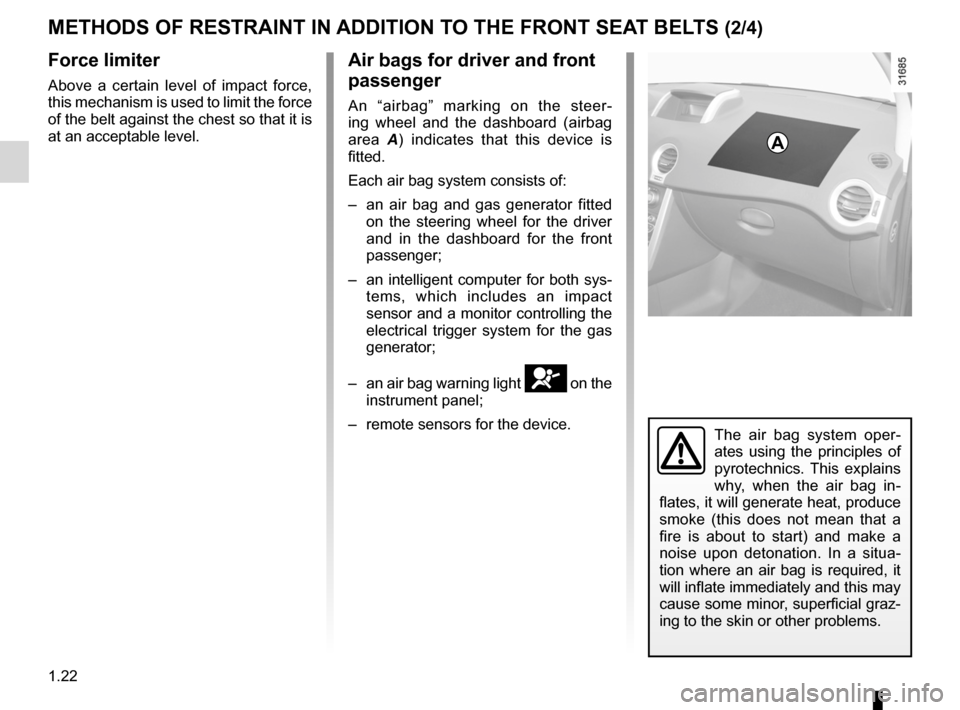
1.22
ENG_UD23486_3
Dispositifs complémentaires à la ceinture avant (X45 - H45 - Renault)
ENG_NU_977-2_H45_Ph2_Renault_1
Jaune NoirNoir texte
METhOds Of REsTRAINT IN AddITION TO ThE fRONT sEAT BELTs (2/4)
force limiter
Above a certain level of impact force,
this mechanism is used to limit the force
of the belt against the chest so that it is
at an acceptable level.
Air bags for driver and front
passenger
An “airbag” marking on the steer -
ing wheel and the dashboard (airbag
area A ) indicates that this device is
fitted.
Each air bag system consists of:
– an air bag and gas generator fitted
on the steering wheel for the driver
and in the dashboard for the front
passenger;
– an intelligent computer for both sys-
tems, which includes an impact
sensor and a monitor controlling the
electrical trigger system for the gas
generator;
– an air bag warning light
å on the
instrument panel;
– remote sensors for the device.
The air bag system oper -
ates using the principles of
pyrotechnics. This explains
why, when the air bag in -
flates, it will generate heat, produce
smoke (this does not mean that a
fire is about to start) and make a
noise upon detonation. In a situa -
tion where an air bag is required, it
will inflate immediately and this may
cause some minor, superficial graz-
ing to the skin or other problems.
A
Page 63 of 233
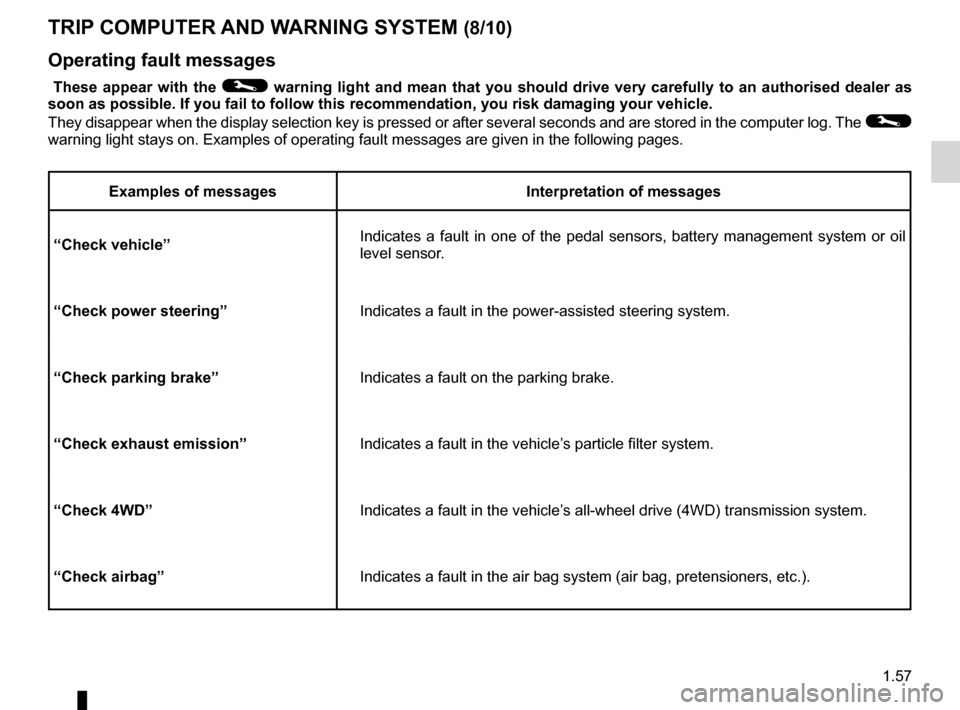
JauneNoirNoir texte
1.57
ENG_UD27277_8
Ordinateur de bord (X45 - H45 - Renault)
ENG_NU_977-2_H45_Ph2_Renault_1
Operating fault messages
These appear with the © warning light and mean that you should drive very carefully to an authorised dealer as
soon as possible. If you fail to follow this recommendation, you risk damaging your vehicle.
They disappear when the display selection key is pressed or after several seconds and are stored in the computer log. The
©
warning light stays on. Examples of operating fault messages are given in the following pages.
Examples of messages Interpretation of messages
“check vehicle” Indicates a fault in one of the pedal sensors, battery management system or oil
level sensor.
“check power steering” Indicates a fault in the power-assisted steering system.
“check parking brake” Indicates a fault on the parking brake.
“check exhaust emission” Indicates a fault in the vehicle’s particle filter system.
“check 4Wd” Indicates a fault in the vehicle’s all-wheel drive (4WD) transmission system.
“check airbag” Indicates a fault in the air bag system (air bag, pretensioners, etc.).
TRIp cOMpUTER ANd WARNINg sYsTEM (8/10)
Page 73 of 233
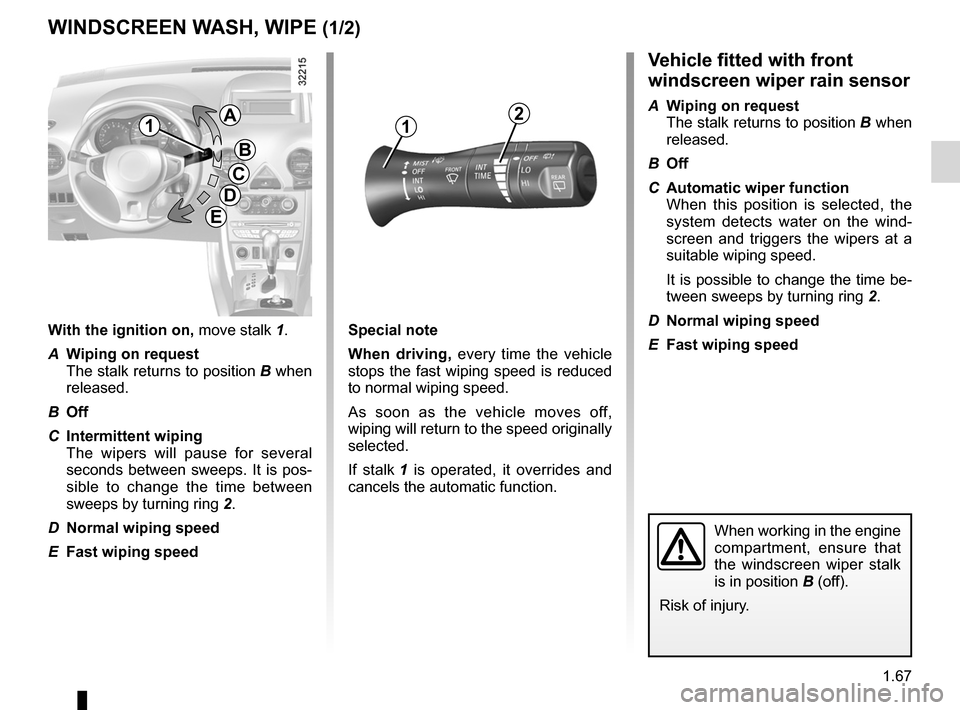
screen wash/wipe ................................. (up to the end of the DU)
windscreen washer ............................... (up to the end of the DU)
1.67
ENG_UD27146_5
Essuie-vitre, lave-vitre avant (X45 - H45 - Renault)
ENG_NU_977-2_H45_Ph2_Renault_1
Front windscreen wash/wiper
WINdscREEN WAsh, WIpE (1/2)
With the ignition on, move stalk 1.
A Wiping on request
The stalk returns to position B when
released.
B Off
C Intermittent wiping
The wipers will pause for several
seconds between sweeps. It is pos-
sible to change the time between
sweeps by turning ring 2.
D Normal wiping speed
E fast wiping speedspecial note
When driving, every time the vehicle
stops the fast wiping speed is reduced
to normal wiping speed.
As soon as the vehicle moves off,
wiping will return to the speed originally
selected.
If stalk 1 is operated, it overrides and
cancels the automatic function.
v ehicle fitted with front
windscreen wiper rain sensor
A Wiping on request
The stalk returns to position B when
released.
B Off
C Automatic wiper function
When this position is selected, the
system detects water on the wind -
screen and triggers the wipers at a
suitable wiping speed.
It is possible to change the time be-
tween sweeps by turning ring 2.
D Normal wiping speed
E fast wiping speed
When working in the engine
compartment, ensure that
the windscreen wiper stalk
is in position B (off).
Risk of injury.
121A
B
c
d
E
Page 79 of 233
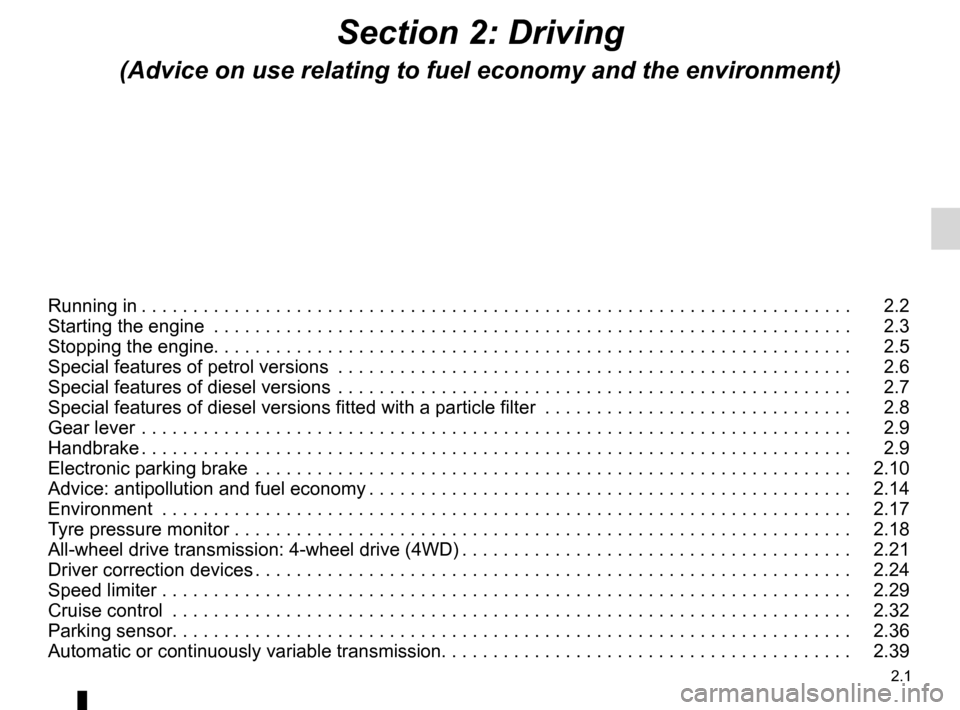
2.1
ENG_UD27164_2
Contents 2 (X45 - H45 - Renault)
ENG_NU_977-2_H45_Ph2_Renault_2
Section 2: Driving
(Advice on use relating to fuel economy and the environment)
Running in . . . . . . . . . . . . . . . . . . . . . . . . . . . . . . . . . . . . . . . . . . . . . . . . . . . . . . . . . . . . . . . . . . . . . 2.2
Starting the engine . . . . . . . . . . . . . . . . . . . . . . . . . . . . . . . . . . . . . . . . . . . . . . . . . . . . . . . . . . . . . . 2.3
Stopping the engine . . . . . . . . . . . . . . . . . . . . . . . . . . . . . . . . . . . . . . . . . . . . . . . . . . . . . . . . . . . . . . 2.5
Special features of petrol versions . . . . . . . . . . . . . . . . . . . . . . . . . . . . . . . . . . . . . . . . . . . . . . . . . . 2.6
Special features of diesel versions . . . . . . . . . . . . . . . . . . . . . . . . . . . . . . . . . . . . . . . . . . . . . . . . . . 2.7
Special features of diesel versions fitted with a particle filter . . . . . . . . . . . . . . . . . . . . . . . . . . . . . . 2.8
Gear lever . . . . . . . . . . . . . . . . . . . . . . . . . . . . . . . . . . . . . . . . . . . . . . . . . . . . . . . . . . . . . . . . . . . . . 2.9
Handbrake . . . . . . . . . . . . . . . . . . . . . . . . . . . . . . . . . . . . . . . . . . . . . . . . . . . . . . . . . . . . . . . . . . . . . 2.9
Electronic parking brake . . . . . . . . . . . . . . . . . . . . . . . . . . . . . . . . . . . . . . . . . . . . . . . . . . . . . . . . . . 2.10
Advice: antipollution and fuel economy . . . . . . . . . . . . . . . . . . . . . . . . . . . . . . . . . . . . . . . . . . . . . . . 2.14
Environment . . . . . . . . . . . . . . . . . . . . . . . . . . . . . . . . . . . . . . . . . . . . . . . . . . . . . . . . . . . . . . . . . . . 2.17
Tyre pressure monitor . . . . . . . . . . . . . . . . . . . . . . . . . . . . . . . . . . . . . . . . . . . . . . . . . . . . . . . . . . . . 2.18
All-wheel drive transmission: 4-wheel drive (4WD) . . . . . . . . . . . . . . . . . . . . . . . . . . . . . . . . . . . . . . 2.21
Driver correction devices . . . . . . . . . . . . . . . . . . . . . . . . . . . . . . . . . . . . . . . . . . . . . . . . . . . . . . . . . . 2.24
Speed limiter . . . . . . . . . . . . . . . . . . . . . . . . . . . . . . . . . . . . . . . . . . . . . . . . . . . . . . . . . . . . . . . . . . . 2.29
Cruise control . . . . . . . . . . . . . . . . . . . . . . . . . . . . . . . . . . . . . . . . . . . . . . . . . . . . . . . . . . . . . . . . . . 2.32
Parking sensor . . . . . . . . . . . . . . . . . . . . . . . . . . . . . . . . . . . . . . . . . . . . . . . . . . . . . . . . . . . . . . . . . . 2.36
Automatic or continuously variable transmission . . . . . . . . . . . . . . . . . . . . . . . . . . . . . . . . . . . . . . . . 2.39
Page 95 of 233
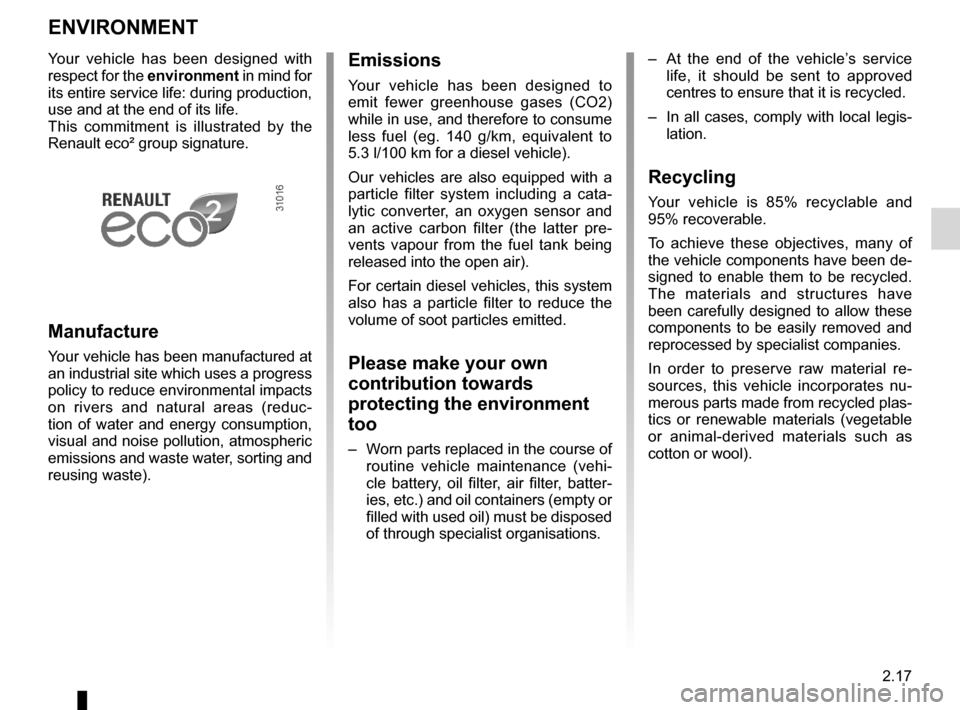
environment .......................................... (up to the end of the DU)
2.17
ENG_UD20974_4
Environnement (X35 - X44 - X45 - H45 - X65 - S65 - X77 - X81 - X85 - X91 - D91 - X76 - X83 - X61 - B65 - C65 - X77 ph2 - X95 - E95 - J95 - R95 - L38 - E33 - X33 - X38
ENG_NU_977-2_H45_Ph2_Renault_2
Environment
ENvIRONMENT
Emissions
Your vehicle has been designed to
emit fewer greenhouse gases (CO2)
while in use, and therefore to consume
less fuel (eg. 140 g/km, equivalent to
5.3 l/100 km for a diesel vehicle).
Our vehicles are also equipped with a
particle filter system including a cata -
lytic converter, an oxygen sensor and
an active carbon filter (the latter pre -
vents vapour from the fuel tank being
released into the open air).
For certain diesel vehicles, this system
also has a particle filter to reduce the
volume of soot particles emitted.
Please make your own
contribution towards
protecting the environment
too
– Worn parts replaced in the course of
routine vehicle maintenance (vehi -
cle battery, oil filter, air filter, batter -
ies, etc.) and oil containers (empty or
filled with used oil) must be disposed
of through specialist organisations. –
At the end of the vehicle’s service
life, it should be sent to approved
centres to ensure that it is recycled.
– In all cases, comply with local legis -
lation.
Recycling
Your vehicle is 85% recyclable and
95% recoverable.
To achieve these objectives, many of
the vehicle components have been de-
signed to enable them to be recycled.
The materials and structures have
been carefully designed to allow these
components to be easily removed and
reprocessed by specialist companies.
In order to preserve raw material re -
sources, this vehicle incorporates nu -
merous parts made from recycled plas-
tics or renewable materials (vegetable
or animal-derived materials such as
cotton or wool).
Your vehicle has been designed with
respect for the
environment in mind for
its entire service life: during production,
use and at the end of its life.
This commitment is illustrated by the
Renault eco² group signature.
Manufacture
Your vehicle has been manufactured at
an industrial site which uses a progress
policy to reduce environmental impacts
on rivers and natural areas (reduc -
tion of water and energy consumption,
visual and noise pollution, atmospheric
emissions and waste water, sorting and
reusing waste).
Page 96 of 233
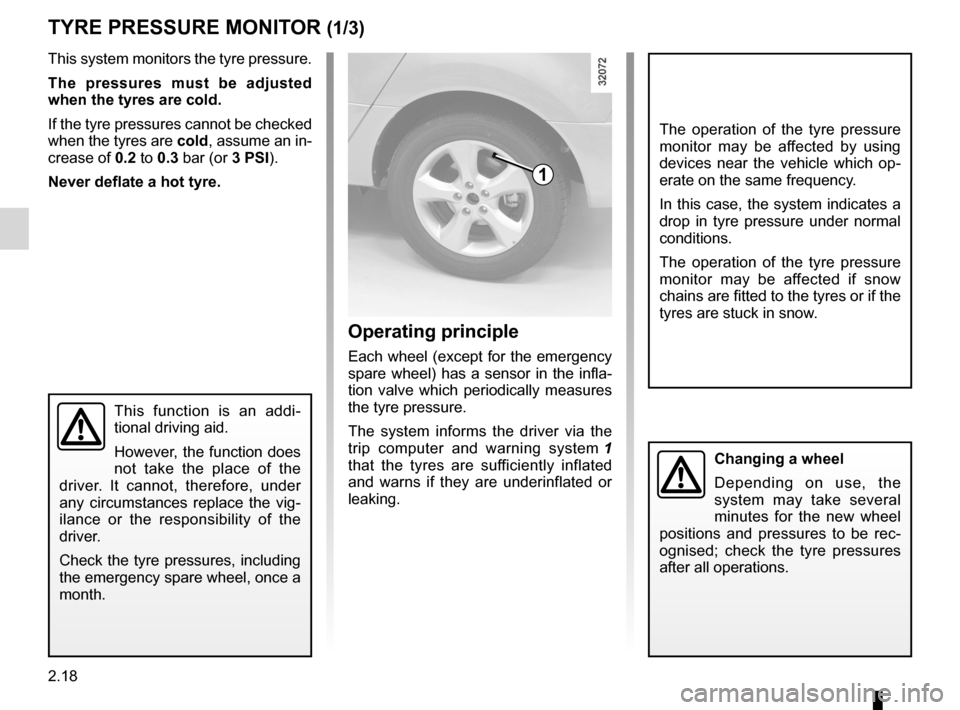
tyres ...................................................... (up to the end of the DU)
tyre pressure monitor ............................(up to the end of the DU)
tyre pressure ......................................... (up to the end of the DU)
driving ................................................... (up to the end of the DU)
2.18
ENG_UD27289_6
Syst me de surveillance de pression des pneumatiques (X45 - H45 - Renault)
ENG_NU_977-2_H45_Ph2_Renault_2
Jaune NoirNoir texte
Tyre pressure monitor
TYRE PRESSURE MONITOR (1/3)
This system monitors the tyre pressure.
The pressures must be adjusted
when the tyres are cold.
If the tyre pressures cannot be checked
when the tyres are cold, assume an in-
crease of 0.2 to 0.3 bar (or 3 PSI).
Never deflate a hot tyre.
Operating principle
Each wheel (except for the emergency
spare wheel) has a sensor in the infla-
tion valve which periodically measures
the tyre pressure.
The system informs the driver via the
trip computer and warning system 1
that the tyres are sufficiently inflated
and warns if they are underinflated or
leaking.
1
This function is an addi -
tional driving aid.
However, the function does
not take the place of the
driver. It cannot, therefore, under
any circumstances replace the vig -
ilance or the responsibility of the
driver.
Check the tyre pressures, including
the emergency spare wheel, once a
month.
The operation of the tyre pressure
monitor may be affected by using
devices near the vehicle which op -
erate on the same frequency.
In this case, the system indicates a
drop in tyre pressure under normal
conditions.
The operation of the tyre pressure
monitor may be affected if snow
chains are fitted to the tyres or if the
tyres are stuck in snow.
Changing a wheel
Depending on use, the
system may take several
minutes for the new wheel
positions and pressures to be rec -
ognised; check the tyre pressures
after all operations.
Page 97 of 233
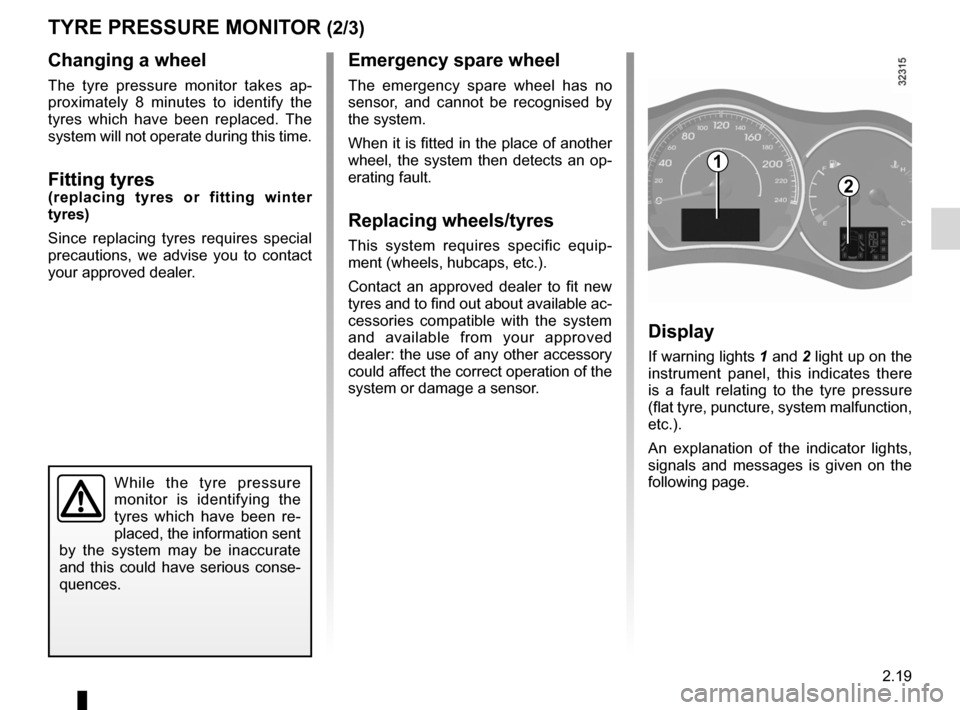
JauneNoirNoir texte
2.19
ENG_UD27289_6
Syst me de surveillance de pression des pneumatiques (X45 - H45 - Renault)
ENG_NU_977-2_H45_Ph2_Renault_2
TYRE PRESSURE MONITOR (2/3)
Changing a wheel
The tyre pressure monitor takes ap -
proximately 8 minutes to identify the
tyres which have been replaced. The
system will not operate during this time.
Fitting tyres(replacing tyres or fitting winter
tyres)
Since replacing tyres requires special
precautions, we advise you to contact
your approved dealer.
While the tyre pressure
monitor is identifying the
tyres which have been re -
placed, the information sent
by the system may be inaccurate
and this could have serious conse-
quences.
Emergency spare wheel
The emergency spare wheel has no
sensor, and cannot be recognised by
the system.
When it is fitted in the place of another
wheel, the system then detects an op-
erating fault.
Replacing wheels/tyres
This system requires specific equip -
ment (wheels, hubcaps, etc.).
Contact an approved dealer to fit new
tyres and to find out about available ac-
cessories compatible with the system
and available from your approved
dealer: the use of any other accessory
could affect the correct operation of the
system or damage a sensor.
Display
If warning lights 1 and 2 light up on the
instrument panel, this indicates there
is a fault relating to the tyre pressure
(flat tyre, puncture, system malfunction,
etc.).
An explanation of the indicator lights,
signals and messages is given on the
following page.
1
2
Page 98 of 233
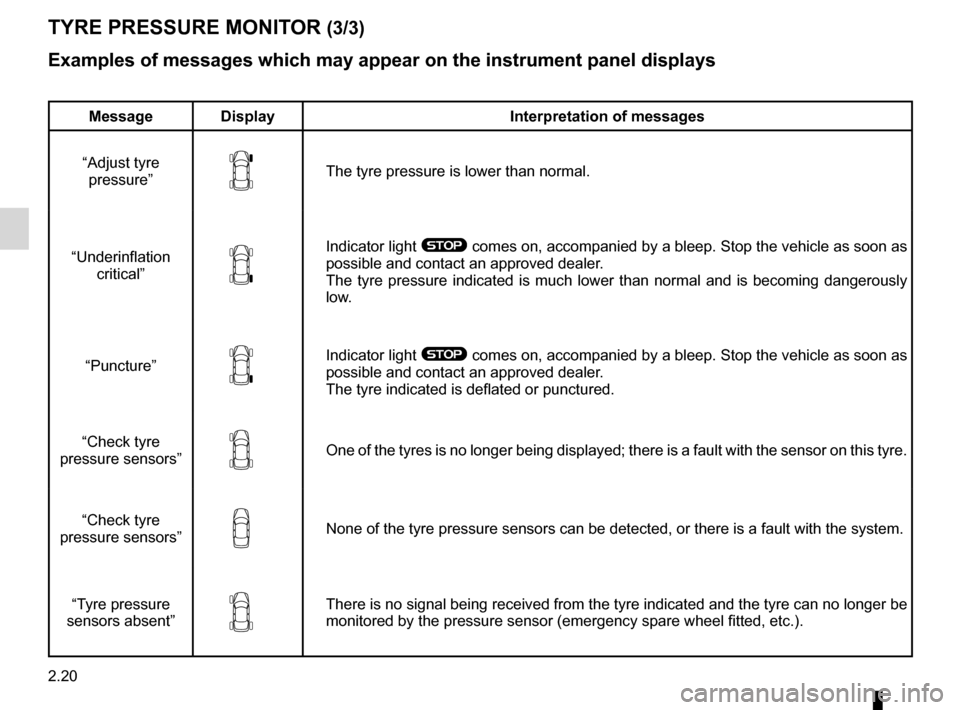
2.20
ENG_UD27289_6
Syst me de surveillance de pression des pneumatiques (X45 - H45 - Renault)
ENG_NU_977-2_H45_Ph2_Renault_2
TYRE PRESSURE MONITOR (3/3)
Examples of messages which may appear on the instrument panel displays
Message Display Interpretation of messages
“Adjust tyre pressure ”
The tyre pressure is lower than normal.
“Underinflation critical”
Indicator light ® comes on, accompanied by a bleep. Stop the vehicle as soon as
possible and contact an approved dealer.
The tyre pressure indicated is much lower than normal and is becoming dangerously
low.
“Puncture”
Indicator light ® comes on, accompanied by a bleep. Stop the vehicle as soon as
possible and contact an approved dealer.
The tyre indicated is deflated or punctured.
“Check tyre
pressure sensors ”
One of the tyres is no longer being displayed; there is a fault with the sensor on this tyre.
“Check tyre
pressure sensors ”
None of the tyre pressure sensors can be detected, or there is a fault with the system.
“Tyre pressure
sensors absent ”
There is no signal being received from the tyre indicated and the tyre can no longer be
monitored by the pressure sensor (emergency spare wheel fitted, etc.).
Page 103 of 233
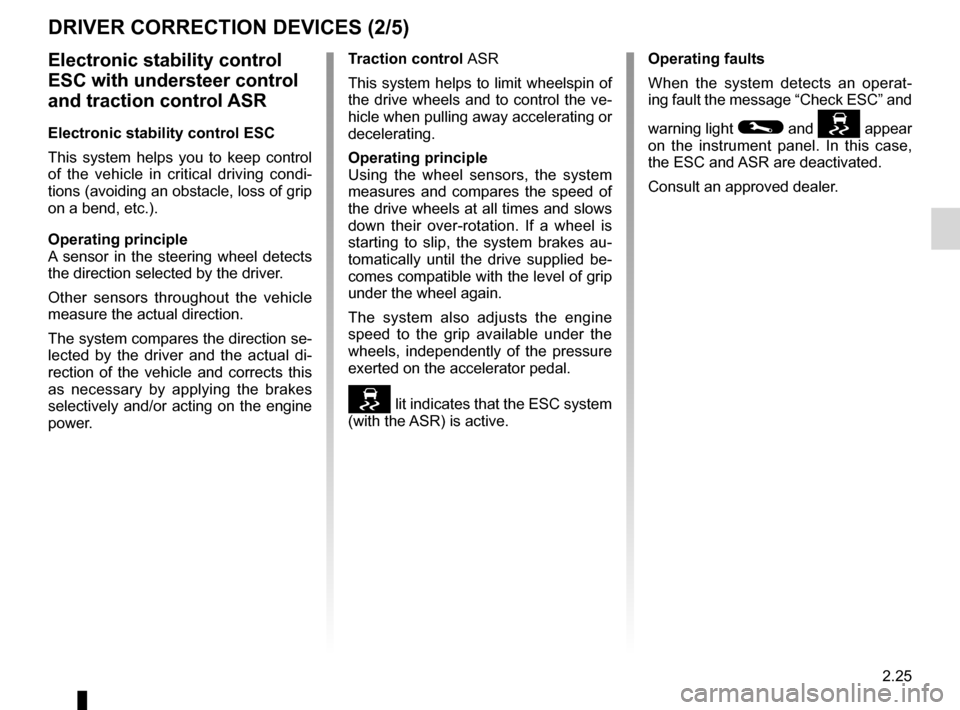
JauneNoirNoir texte
2.25
ENG_UD27148_7
Dispositifs de correction et d’assistance la conduite (X45 - H45 - Renault)
ENG_NU_977-2_H45_Ph2_Renault_2
DRIvER CORRECTION DEvICES (2/5)
Electronic stability control
ESC with understeer control
and traction control ASR
Electronic stability control ESC
This system helps you to keep control
of the vehicle in critical driving condi -
tions (avoiding an obstacle, loss of grip
on a bend, etc.).
Operating principle
A sensor in the steering wheel detects
the direction selected by the driver.
Other sensors throughout the vehicle
measure the actual direction.
The system compares the direction se-
lected by the driver and the actual di -
rection of the vehicle and corrects this
as necessary by applying the brakes
selectively and/or acting on the engine
power. Traction control
ASR
This system helps to limit wheelspin of
the drive wheels and to control the ve-
hicle when pulling away accelerating or
decelerating.
Operating principle
Using the wheel sensors, the system
measures and compares the speed of
the drive wheels at all times and slows
down their over-rotation. If a wheel is
starting to slip, the system brakes au -
tomatically until the drive supplied be -
comes compatible with the level of grip
under the wheel again.
The system also adjusts the engine
speed to the grip available under the
wheels, independently of the pressure
exerted on the accelerator pedal.
lit indicates that the ESC system
(with the ASR) is active. Operating faults
When the system detects an operat
-
ing fault the message “Check ESC” and
warning light
© and appear
on the instrument panel. In this case,
the ESC and ASR are deactivated.
Consult an approved dealer.
Page 114 of 233

parking distance control........................(up to the end of the DU)
driving ................................................... (up to the end of the DU)
reversing sensor ................................... (up to the end of the DU)
2.36
ENG_UD27281_8
Aide au parking (X45 - H45 - Renault)
ENG_NU_977-2_H45_Ph2_Renault_2
Jaune NoirNoir texte
Parking sensor
Operating principle
On equipped vehicles, ultrasonic sen -
sors fitted in the vehicle’s rear and/or
front bumper measure the distance
between the vehicle and an obstacle
when reversing.
This measurement is indicated by
beeps which become more frequent the
closer you come to the obstacle, until
they become a continuous beep when
the vehicle is approximately 25 centi -
metres from the obstacle.
Special features
Ensure that the ultrasonic sensors are
not obscured (by dirt, mud, snow, etc.).
This function is an additional aid that indicates the distance between the
vehicle and an obstacle whilst reversing, using sound signals.
Under no circumstances should it replace the driver’s care or responsibil -
ity whilst reversing.
The driver should always look out for sudden hazards during driving: always
ensure that there are no moving obstacles (such as a child, animal, pram or bi-
cycle, etc.) or small, narrow objects such as stones or posts in your path when
manoeuvring.
PARKING DISTANCE CONTROL (1/3)
Front parking distance
control
(Depending on the vehicle)
Operation
when moving forwards at less than
7 mph (12 km/h), when any object
is detected less than approximately
1 metre from the front of the vehicle: a
beep sounds.
Automatic activation/deactivation of
front parking distance control
The system deactivates:
– when the vehicle speed is above ap-
proximately 7 mph (12 km/h);
– When the vehicle is stationary for
more than three seconds: only in the
case that the vehicle speed dropped
from above approximately 7 mph
(12 km/h) and an obstacle is more
than 30 centimetres away from the
vehicle (e.g., traffic jam);
– when the vehicle is in neutral or
when the gear lever has been shifted
to N or P for automatic gearboxes.